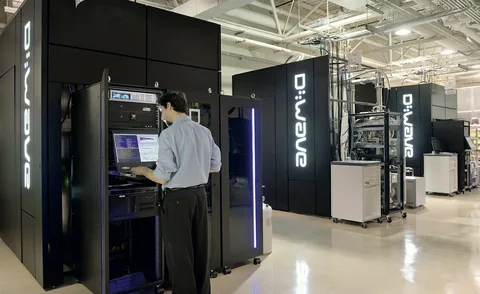Quantum Computing Computers | The Science, The Myths & The Future
Quantum computing is no longer just a sci-fi concept—it’s a reality that’s reshaping the future of technology. From solving problems that classical computers can’t handle to posing existential threats to cybersecurity, quantum computing is a double-edged sword. In this blog, we’ll dive into the science behind it, debunk common myths, and explore what the future holds for this groundbreaking technology.
What is Quantum Computing? Breaking Down the Basics
The Coin Flip Analogy
Imagine flipping a coin. A classical computer sees it as either heads (0) or tails (1). But a quantum computer lets the coin spin in mid-air, existing as both heads and tails at the same time. This is the magic of quantum bits (qubits).
How It Works
- Superposition: Qubits can be 0, 1, or both simultaneously.
- Entanglement: Qubits can be linked, so the state of one affects the other, no matter the distance.
- Quantum Interference: Manipulates probabilities to amplify correct answers and cancel errors.
Why It Matters: Quantum computers can explore multiple solutions at once, making them ideal for tasks like cracking encryption, optimizing supply chains, and simulating molecules.
The Biggest Problem with Quantum Computing | Decoherence
The Achilles’ Heel of Quantum Computers
Quantum states are incredibly fragile. Even the slightest environmental “noise”—heat, vibrations, or electromagnetic waves—can disrupt qubits, causing decoherence.
- Why It’s a Problem: Decoherence leads to errors in calculations, making quantum computers unreliable.
- Current Fixes: Quantum computers require cryogenic cooling (near absolute zero) and advanced error-correction algorithms.
The Bottom Line: Until we solve decoherence, practical, large-scale quantum computers will remain a dream.

Real-Life Examples of Quantum Computing in Action
Optimizing Traffic with D-Wave
In 2017, Volkswagen used D-Wave’s quantum annealer to optimize traffic flow in Beijing. By analyzing data from 10,000 taxis, they reduced travel times by 20%.
Revolutionizing Drug Discovery
Pharmaceutical companies like Roche are using quantum simulations to model molecular interactions, speeding up the development of life-saving drugs.
Financial Modeling
JPMorgan is experimenting with quantum algorithms to predict market risks and optimize investment portfolios.
Takeaway: While still in its infancy, quantum computing is already making waves in industries like logistics, healthcare, and finance.
Has Anyone Built a Quantum Computer Yet?
Yes, But They’re Not in Your Living Room
Several organizations have built functional quantum computers:
| Company | Achievement |
|---|---|
| Achieved “quantum supremacy” in 2019 with Sycamore (53 qubits). | |
| IBM | Offers cloud access to its 433-qubit Osprey processor. |
| D-Wave | Specializes in quantum annealing for optimization (5,000+ qubits). |
| Rigetti | Focuses on hybrid quantum-classical systems for practical applications. |
Catch: These machines are experimental, expensive, and require specialized labs.
The Origin of Quantum Computing: From Theory to Reality
The Pioneers
- 1980s: Physicist Richard Feynman proposed the idea of quantum computers to simulate quantum systems.
- 1994: Peter Shor developed Shor’s algorithm, showing quantum computers could break RSA encryption.
- 1998: The first 2-qubit quantum computer was built at Oxford University.
Key Milestones
- 2016: IBM puts the first quantum computer on the cloud.
- 2019: Google’s Sycamore achieves quantum supremacy.
Fun Fact: Quantum computing is rooted in the bizarre world of quantum mechanics, where particles can exist in multiple states at once.
Why Did NASA Shut Down Its Quantum Computer?
The D-Wave Experiment
In 2013, NASA partnered with Google and D-Wave to explore quantum computing for space missions. By 2019, the project was shelved due to:
- Sky-High Costs: Maintaining cryogenic systems cost millions annually.
- Unreliable Results: High error rates made calculations untrustworthy.
- Better Alternatives: NASA shifted focus to classical supercomputers like Pleiades for rocket simulations.
Legacy: The research advanced quantum annealing techniques now used in logistics and AI.
The Disadvantages of Quantum Computers
Five Major Drawbacks
- Cost: Building one requires ~$10 million+ for cooling and shielding.
- Fragility: Qubits lose coherence in milliseconds.
- Niche Usefulness: Only excel at specific tasks (e.g., optimization, cryptography).
- Skill Gap: Few programmers understand quantum languages like Qiskit.
- Security Risks: Threaten to crack RSA encryption, endangering global data.
The Reality: Quantum computers are not yet ready to replace classical computers.
The Dark Side of Quantum Computing
Ethical and Security Threats
- Cybersecurity Apocalypse:
- Quantum computers could decrypt bank transactions, military secrets, and blockchain.
- Solution: Post-quantum cryptography (e.g., lattice-based encryption).
- Quantum Arms Race:
- Governments like the U.S. and China invest billions to dominate quantum warfare (e.g., unhackable communications, advanced surveillance).
- AI Gone Wild:
- Quantum-powered AI could manipulate markets, create undetectable deepfakes, or automate cyberattacks.
- Job Disruption:
- Roles in cybersecurity, logistics, and finance may vanish as quantum algorithms replace classical methods.
The Warning: Quantum computing is a powerful tool, but it must be used responsibly.
The Future of Quantum Computing: What’s Next?
Short-Term Goals (2020s)
- Error-Corrected Qubits: Making quantum computers more stable and reliable.
- Hybrid Systems: Combining quantum and classical computing for practical applications.
Long-Term Vision (2030s+)
- Scalable Quantum Computers: Machines powerful enough for mainstream use.
- Quantum Internet: Ultra-secure communication networks.
Industries That Will Benefit:
- Pharmaceuticals: Accelerating drug discovery.
- Finance: Enhancing risk analysis and trading.
- Logistics: Optimizing supply chains.
- AI: Speeding up machine learning.
Conclusion | A Quantum Leap into the Unknown
Quantum computing is poised to revolutionize science, security, and industry. But with great power comes great responsibility. As we stand on the brink of this technological revolution, we must address the ethical, security, and stability challenges that come with it.
The future of quantum computing is bright—but only if we navigate its dark side with caution and foresight.




Post Comment